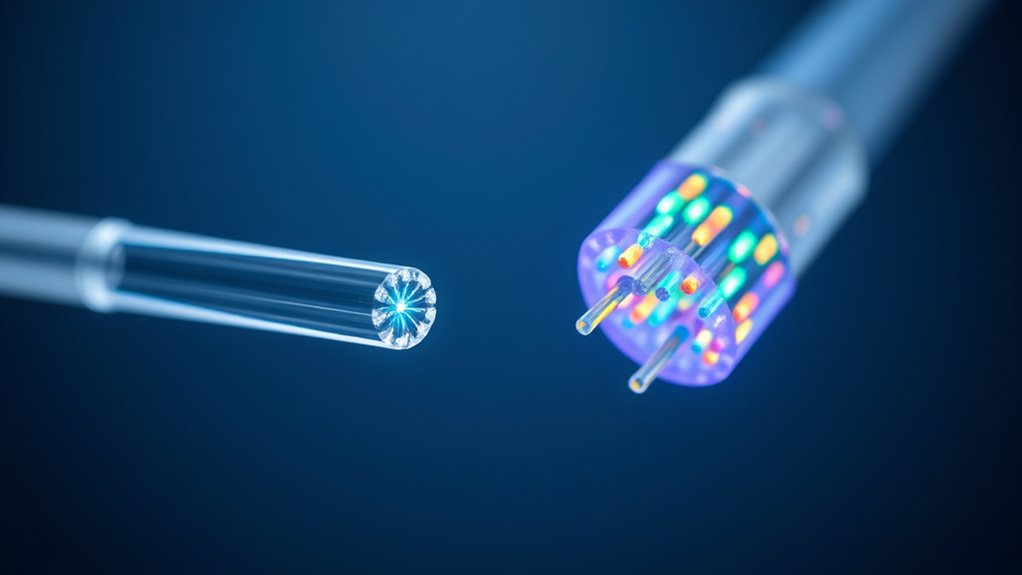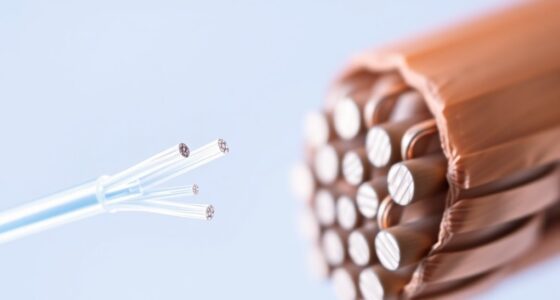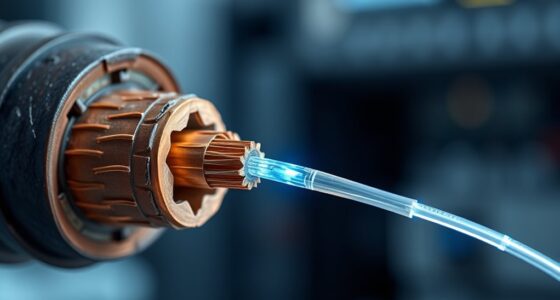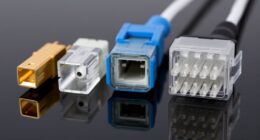Single-mode fibers have a small core (8-10 microns) that transmits light straight down, making them ideal for long distances and high data rates. Multi-mode fibers have a larger core (50-62.5 microns), supporting multiple light paths and shorter distances. They’re easier to install and cheaper but offer lower bandwidth. Your choice depends on your network’s distance and performance needs—learn more to find the best fit for your environment.
Key Takeaways
- Single-mode fibers have smaller cores (~8–10 microns) enabling high data rates and long-distance transmission with minimal signal loss.
- Multi-mode fibers feature larger cores (~50–62.5 microns), suitable for short-distance, high-density applications with easier installation.
- Single-mode cables support higher bandwidths and are ideal for long-haul networks; multi-mode cables are cost-effective for shorter, local connections.
- Single-mode fibers require precise connectors and handling, while multi-mode fibers are more tolerant of imperfections and simpler to deploy.
- Cost, performance, and application environment determine the appropriate choice: single-mode for long-distance, multi-mode for short-range needs.
Structural Differences Between Single-Mode and Multi-Mode Fibers

Understanding the structural differences between single-mode and multi-mode fibers is essential for selecting the right cable for your needs. Single-mode fibers have a tiny core, about 8 to 10 microns, allowing light to travel straight down with minimal bending issues. This design reduces fiber bending losses, making them ideal for long-distance applications. Multi-mode fibers, with a larger core of about 50 to 62.5 microns, support multiple light paths, which can lead to modal dispersion over longer spans. Connector types also differ; single-mode cables typically use precision connectors like SC or LC, optimized for minimal signal loss, while multi-mode cables often employ more robust connectors. Understanding these structural differences helps you choose the right fiber based on your transmission distance, bending requirements, and connector compatibility. Additionally, the difference in core size directly impacts the bandwidth capacity of each fiber type, influencing their suitability for various data transmission needs.
Light Transmission Mechanisms and Core Sizes
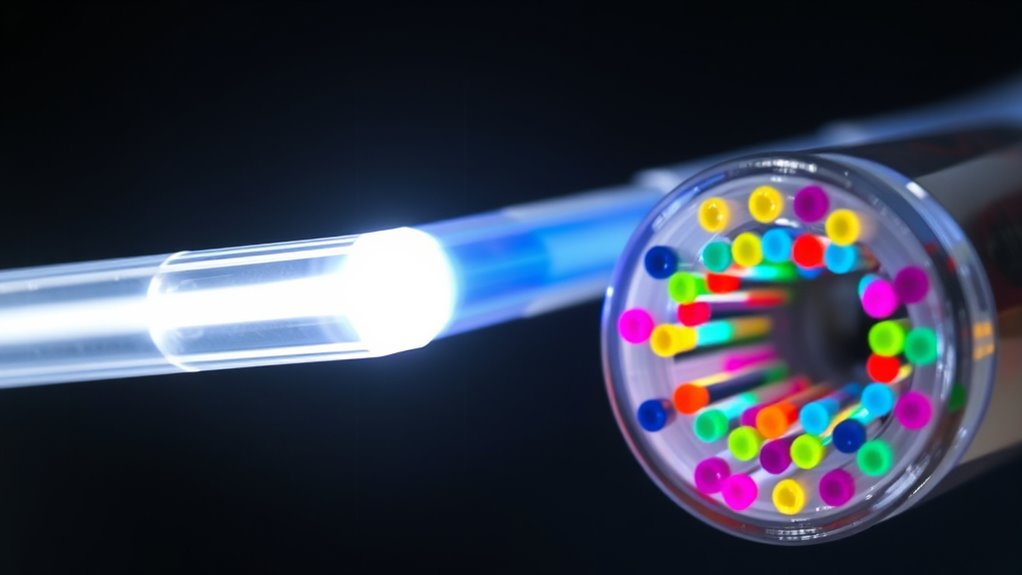
The way light travels through single-mode and multi-mode fibers depends largely on their core sizes and transmission mechanisms. Single-mode fibers have tiny fiber core diameters, typically around 8 to 10 micrometers, allowing light to travel straight down the fiber with minimal reflection. This enables light to follow a direct, straight-line path, known as the light propagation mechanism, resulting in lower signal loss over long distances. Conversely, multi-mode fibers feature larger core diameters, usually 50 to 62.5 micrometers, which cause light to bounce off the core walls, creating multiple paths. These different propagation paths, driven by their core sizes, influence how light moves through the fibers, affecting overall performance and suitability for specific applications. The choice between single-mode and multi-mode fibers depends heavily on the required bandwidth and distance of the transmission. Automation technologies play a role in manufacturing and testing fiber optics, ensuring quality and precision in their performance. Additionally, the core size significantly impacts the fiber’s ability to handle high data rates and long-distance transmission efficiently, especially with advancements in fiber optic technology.
Bandwidth Capabilities and Data Rates

Single‑mode fibers typically support higher bandwidths and faster data rates than multi-mode fibers because their precise light transmission reduces modal dispersion. This advantage allows data to travel longer distances with minimal signal loss, making them ideal for high-speed networks. When connecting these fibers, fiber optic connectors must be carefully chosen to guarantee top-notch signal integrity and minimal insertion loss. Additionally, cable shielding plays a crucial role in protecting signals from electromagnetic interference, further enhancing data transmission quality. Multi-mode fibers, while supporting lower data rates, often use simpler connectors and less shielding, suitable for shorter distances. Overall, if your goal is maximum bandwidth and speed over extended runs, single-mode fiber with proper connectors and shielding is your best choice. Incorporating the appropriate Tuning options can further optimize network performance for specific needs. Moreover, selecting fiber optic cable with proper shielding can significantly improve overall signal stability and reduce interference effects.
Typical Use Cases and Application Environments
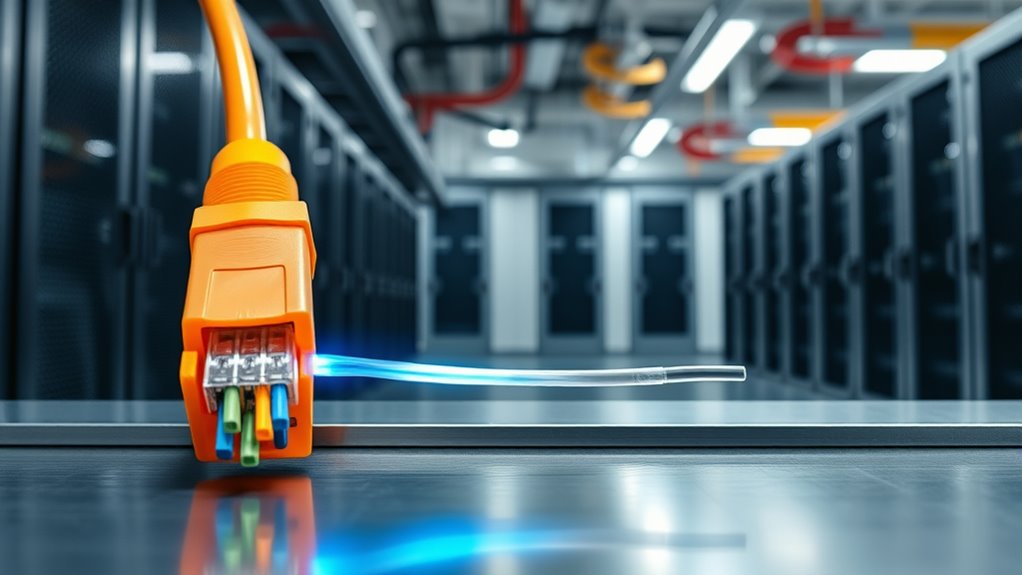
You’ll find single-mode and multi-mode fibers in different environments based on their strengths. Data centers often use multi-mode cables for short-distance connections, while long-haul telecom networks rely on single-mode fibers for extended distances. Building networks, depending on size and scope, may choose either type to optimize performance and cost. Additionally, selecting the appropriate fiber type can be influenced by the material properties and specific application requirements.
Data Center Deployments
Choosing the right fiber cable type is essential for optimizing data center performance. Multi-mode fibers suit short-distance links within data centers, supporting higher data rates with less complex fiber optic connectors. Multi-mode fibers are typically easier to install and maintain, making them a popular choice for many applications. Single-mode fibers excel over longer distances, maintaining signal integrity through advanced signal modulation techniques. When selecting cables, consider your bandwidth needs and future scalability. Multi-mode cables often use LED-based transmitters, making them cost-effective for high-density environments. Single-mode cables utilize laser-based transmitters for minimal attenuation over long runs. Use the table below to compare typical deployments: Understanding fiber types is crucial for selecting the appropriate solution.
Long-Haul Telecommunications
Long-haul telecommunications demand fiber optic cables that can transmit signals over extensive distances without significant loss. Single-mode fibers are ideal here, as they minimize signal degradation, making long-distance transmission efficient. When deploying these cables, guarantee you select high-quality fiber optic connectors to maintain peak signal integrity. Proper cable shielding is vital, protecting against electromagnetic interference and physical damage, especially over vast stretches. Additionally, using fiber optic connectors that are compatible with the cable type ensures optimal signal transfer and reduces connection issues. The use of signal attenuation management techniques further enhances the quality of long-distance transmissions by reducing signal loss over extended runs. Effective installation practices are crucial to prevent damage and ensure the longevity of the fiber network. Multi-mode fibers are less suitable for long-haul use due to higher attenuation, but they still find applications in regional networks. The combination of robust cable shielding and reliable fiber optic connectors ensures your network maintains performance and durability over long distances. This setup supports high-speed data transfer essential for telecommunications providers, guaranteeing seamless connectivity across cities and countries. Additionally, implementing proper installation techniques can significantly enhance overall network performance and longevity.
Building Network Infrastructures
Building network infrastructures involves deploying fiber optic cables tailored to specific environments and use cases. For office buildings, data centers, or campus networks, multi-mode fiber often suffices due to shorter distances and high bandwidth needs. In industrial environments, single-mode fiber with rugged fiber optic connectors ensures durability and long-distance performance. Proper cable bundling helps manage large volumes of cables, reducing clutter and maintaining signal integrity. Selecting the right fiber type depends on application requirements, such as distance, speed, and environmental factors. Here’s a quick comparison:
| Use Case | Fiber Type | Key Focus |
|---|---|---|
| Data centers | Multi-mode fiber | High bandwidth, short runs |
| Long-distance links | Single-mode fiber | Low loss, long distances |
| Rugged environments | Single-mode fiber | Durability, fiber optic connectors |
Additionally, understanding fiber optic cable properties helps optimize network performance and longevity. Properly choosing and bundling cables based on application environment can significantly improve network reliability and efficiency. Ensuring that cables are appropriately installed and maintained further enhances overall network performance and lifespan. Adjusting fiber choice and cable bundling strategies keeps your network efficient and reliable, leading to better overall system performance.
Transmission Distance and Signal Attenuation

Single-mode and multi-mode fiber cables differ markedly in how far they can transmit signals before the quality degrades. In single-mode fibers, the signal travels longer distances with minimal attenuation because modal dispersion is negligible. Multi-mode fibers, however, experience higher signal attenuation over shorter distances due to modal dispersion, which causes signal distortion. To optimize performance, consider these points:
- Single-mode fibers allow transmission over tens of kilometers with little signal loss.
- Multi-mode fibers typically support up to a few kilometers before significant attenuation occurs.
- Modal dispersion in multi-mode fibers limits their effective transmission distance.
- Signal attenuation increases with distance, affecting overall network quality and reliability.
Understanding these differences helps you choose the right fiber type for your specific transmission needs.
Cost Considerations and Installation Factors

When choosing between single-mode and multi-mode fibers, you’ll need to take into account material and manufacturing costs, as these can vary considerably. Installation complexity also plays a role, with some setups requiring more technical skill and time. Additionally, think about maintenance expenses and how long the fibers are likely to last, as these factors impact your overall budget. Considering the fiber technology industry’s emphasis on continuous learning and adaptability, staying informed about new fiber technology options can also be beneficial for optimal decision-making. Moreover, understanding the differences in light transmission capabilities can help in selecting the appropriate fiber type for your specific application. Recognizing the importance of connection stability can further influence your choice, especially in environments demanding high reliability.
Material and Manufacturing Costs
Material and manufacturing costs play a significant role in choosing between single-mode and multi-mode fiber cables, as they directly impact your overall budget and deployment timeline. Generally, multi-mode fibers are cheaper to produce due to simpler core structures, but you should consider these factors:
- Fiber optic splicing: Single-mode fibers require precise, costly splicing equipment, increasing overall expenses.
- Connector types: Single-mode connectors are more expensive and delicate, affecting installation costs.
- Raw materials: Multi-mode fibers use less costly materials, reducing initial manufacturing costs.
- Production complexity: Single-mode manufacturing involves tighter tolerances, raising material and labor expenses.
- Manufacturing tolerances also influence the overall quality and consistency of the fiber cables, which can impact long-term performance and maintenance costs.
Understanding these cost elements helps you make an informed decision that balances performance needs with budget constraints.
Installation Complexity Differences
While manufacturing costs differ, installation complexity also considerably influences your overall expenses. Single-mode fibers often require more precise handling and specialized installation tools, such as cleavers and fusion splicers, to guarantee minimal signal loss. Multi-mode fibers are generally easier to install because they tolerate slightly more misalignment, reducing the need for high-precision connector types. Connector types also play a role; single-mode connectors tend to be more delicate and costly, demanding careful handling and precise alignment during installation. In contrast, multi-mode connectors are typically more forgiving and easier to connect with standard tools. Overall, single-mode fiber installation is more complex and time-consuming, often requiring specialized skills and equipment, which can increase your upfront costs.
Maintenance and Longevity Expenses
Maintenance and longevity costs vary considerably between single-mode and multi-mode fiber cables, influenced by their construction and installation requirements. You’ll find that the need for fiber optic cleaning is more frequent with multi-mode cables due to higher connector contamination risks. Additionally, connector durability plays a key role in maintenance expenses. Here are some factors to contemplate:
- Single-mode cables often have higher initial costs but require less frequent cleaning and repairs.
- Multi-mode cables may need more frequent fiber optic cleaning, increasing upkeep.
- Connector durability influences replacement frequency, especially in high-traffic setups.
- Proper installation practices can extend cable life, reducing long-term expenses.
Understanding these factors helps you plan for maintenance, balancing upfront costs with ongoing expenses effectively.
Compatibility and Future-Proofing Your Network

Choosing the right fiber cable is essential for guaranteeing your network remains compatible with current and future technologies. Fiber optic compatibility depends on selecting the appropriate type—single-mode or multi-mode—that aligns with your network’s bandwidth and distance needs. Single-mode fibers are ideal for long-distance connections and high-speed data transmission, offering better network future proofing because they support higher capacities over greater distances. Multi-mode fibers, while suitable for shorter runs, may limit your scalability as your network grows. By considering your current requirements and potential upgrades, you can choose a fiber type that minimizes compatibility issues down the road. Making informed decisions now helps guarantee your network stays adaptable, reducing costly replacements and keeping your infrastructure ready for future advancements.
Advantages and Disadvantages of Each Type
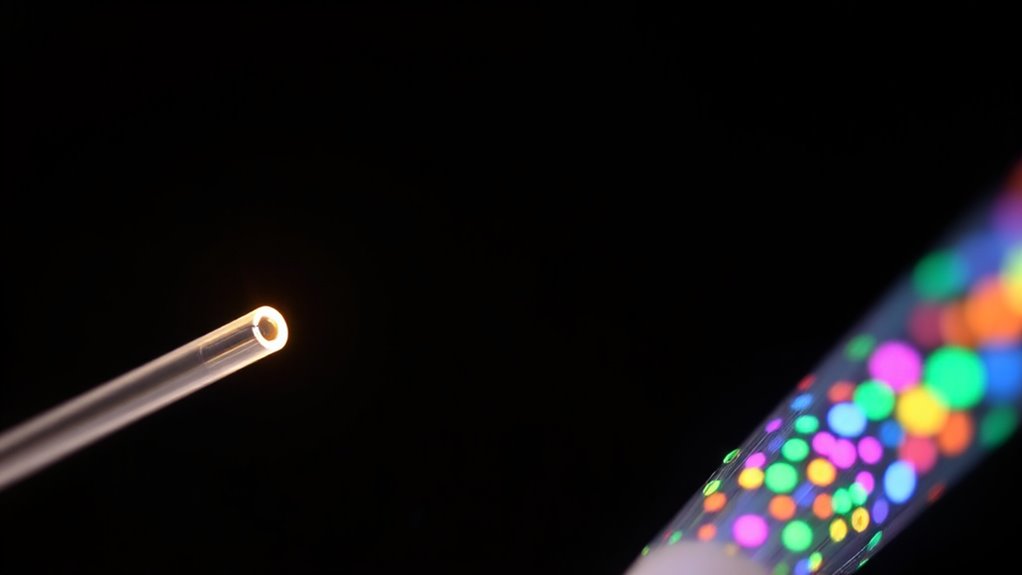
Understanding the advantages and disadvantages of single-mode and multi-mode fiber cables helps you make informed choices tailored to your network’s needs.
- Single-mode fibers offer higher bandwidth and longer distances, but require precise fiber optic connectors and are more sensitive to cable shielding issues.
- Multi-mode fibers are easier to install and cost less initially, yet they have limited reach and lower bandwidth.
- Single-mode cables tend to be thinner and more flexible, but the need for specialized connectors increases complexity.
- Multi-mode cables are more tolerant of connector imperfections and cable shielding variations, making them suitable for shorter, less demanding setups.
Frequently Asked Questions
How Do Environmental Factors Affect Fiber Optic Cable Performance?
Environmental factors can considerably impact your fiber optic cable’s performance by affecting its environmental resilience and mechanical durability. Extreme temperatures, moisture, and UV exposure can cause the cable to degrade or lose signal quality over time. You need to guarantee proper shielding and protective coatings to maintain durability and resilience, especially in challenging environments. Regular inspections and choosing cables designed for specific conditions help preserve ideal performance and extend your cable’s lifespan.
What Are the Maintenance Requirements for Single-Mode Versus Multi-Mode Fibers?
Maintaining fiber optics means mastering meticulous fiber inspection and cleaning procedures. You’ll regularly inspect connectors for dirt or damage, ensuring ideal performance. Clean connectors carefully with appropriate cleaning tools to prevent signal loss. Both fiber types demand diligent, detailed upkeep, but single-mode fibers often require more precise inspection due to their narrower cores. Consistent cleaning and inspection guarantee clarity, curb costly repairs, and keep your connections consistently clean and capable.
Can Multi-Mode Fibers Be Upgraded to Single-Mode Later?
You can’t upgrade multi-mode fibers to single-mode later because of their fundamental differences in core size and design, which affects compatibility. Doing so would involve replacing the entire fiber infrastructure, leading to significant cost implications. If you’re planning for future upgrades, it’s smarter to choose single-mode fibers now, as they support higher bandwidth and longer distances, making them more versatile and cost-effective over time.
What Are the Safety Considerations During Fiber Installation?
Imagine walking through a delicate forest, where every step matters. During fiber installation, you must prioritize laser safety by wearing protective eyewear and avoiding direct eye exposure. Handle fibers with care, using proper tools and techniques to prevent damage and contamination. Always follow handling precautions, keep fibers clean, and be cautious of sharp edges. These steps guarantee your safety and preserve the integrity of the delicate fiber ecosystem you’re nurturing.
How Does Connector Type Impact Fiber Optic Network Performance?
You should consider connector type carefully, as it directly impacts fiber optic network performance. Using compatible connectors guarantees proper connector compatibility, which maintains signal integrity and prevents signal loss. Mismatched or incompatible connectors can cause connection issues, leading to degraded performance and potential network failures. Always verify that your connectors match your fiber type and equipment specifications, guaranteeing reliable data transmission and superior network performance.
Conclusion
Choosing between single-mode and multi-mode fiber cables depends on your specific needs. While each has its subtle nuances, understanding their differences helps you make a wise decision for your network’s future. By considering factors like distance, bandwidth, and budget, you’ll naturally find the best fit. With a little insight, you’ll smoothly navigate your options, ensuring your network remains resilient and ready for what’s ahead—making your connection both seamless and reliable.
